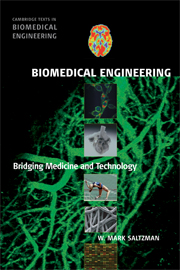Book contents
- Frontmatter
- Contents
- Preface
- Acknowledgments
- Abbreviations and Acronyms
- 1 Introduction: What Is Biomedical Engineering?
- PART 1 MOLECULAR AND CELLULAR PRINCIPLES
- 2 Biomolecular Principles
- 3 Biomolecular Principles: Nucleic Acids
- 4 Biomolecular Principles: Proteins
- 5 Cellular Principles
- PART 2 PHYSIOLOGICAL PRINCIPLES
- PART 3 BIOMEDICAL ENGINEERING
- Appendix A Physiological Parameters
- Appendix B Chemical Parameters
- Appendix C Units and Conversion Factors
- Index
- Plate section
- References
3 - Biomolecular Principles: Nucleic Acids
from PART 1 - MOLECULAR AND CELLULAR PRINCIPLES
- Frontmatter
- Contents
- Preface
- Acknowledgments
- Abbreviations and Acronyms
- 1 Introduction: What Is Biomedical Engineering?
- PART 1 MOLECULAR AND CELLULAR PRINCIPLES
- 2 Biomolecular Principles
- 3 Biomolecular Principles: Nucleic Acids
- 4 Biomolecular Principles: Proteins
- 5 Cellular Principles
- PART 2 PHYSIOLOGICAL PRINCIPLES
- PART 3 BIOMEDICAL ENGINEERING
- Appendix A Physiological Parameters
- Appendix B Chemical Parameters
- Appendix C Units and Conversion Factors
- Index
- Plate section
- References
Summary
LEARNING OBJECTIVES
After reading this chapter, you should:
Understand the importance of deoxyribonucleic acid (DNA) in storing genetic information in cells.
Know the chemical structures of DNA and ribonucleic acid (RNA), and how these chemical structures are related to the functions of these biological macromolecules.
Understand the mechanism of DNA replication and its importance in cell division.
Understand the central dogma of molecular biology and the concepts of biological transcription and translation.
Understand that RNA exists in different forms in the cell, with each form contributing uniquely to the processes of transcription and translation.
Recognize the importance of gene cloning and how recombinant DNA technology has revolutionized biology and biomedical engineering (BME).
Understand the technique of the polymerase chain reaction (PCR) and how it is used to synthesize DNA.
Know the common gene delivery vectors that are used in human cells, as well as their advantages and disadvantages.
Prelude
One of the most fascinating and well-known stories in science is that of the discovery of the structure of DNA, which was accomplished by James Watson and Francis Crick in 1953, when both were young men working at Cavendish Laboratory in Cambridge, England. Watson's autobiographical book, The Double Helix, describes that period of accomplishment, but it retains its popularity because it deals directly with a more general theme. It might be the best description for modern readers of the magical quality of science and its appeal for young people seeking adventure, mystery, and fame.
- Type
- Chapter
- Information
- Biomedical EngineeringBridging Medicine and Technology, pp. 82 - 140Publisher: Cambridge University PressPrint publication year: 2009



